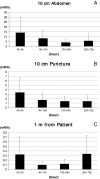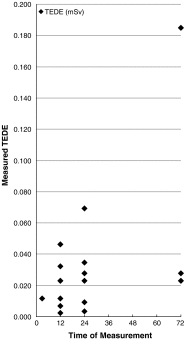Radiation safety issues in y-90 microsphere selective hepatic radioembolization therapy: possible radiation exposure from the patients
- PMID: 24899961
- PMCID: PMC4042917
- DOI: 10.1007/s13139-010-0047-7
Radiation safety issues in y-90 microsphere selective hepatic radioembolization therapy: possible radiation exposure from the patients
Abstract
Purpose: The purpose of this study was to estimate the possible external radiation dose to other individuals from patients treated with Y-90 resin microspheres for unresectable hepatocellular carcinoma.
Methods: We designed the study prospectively to estimate the possible radiation dose to other individuals from patients who had been treated with Y-90 microspheres for unresectable hepatocellular carcinoma. We estimated the total effective dose equivalent (TEDE) using two methods: 'theoretical' TEDEs according to the administered activity and 'measured' TEDE based on the 'measured' ambient radiation exposure rate. We compared the results from each method to determine when we can release patients from confinement at the earliest time complying with the patient release criteria.
Results: A total of 20 administrations of Y-90 resin microspheres were done in 18 patients. The average administered activity was 1.2 ± 0.77 (0.28-2.97) GBq. The 'theoretical' TEDEs were in the range of 0.8-10 μSv. The 'measured' TEDEs were in the range of 2.31-185 μSv. The measured TEDEs tend to be higher than the theoretical TEDEs. The values of theoretical and measured TEDE were both far less than 1 mSv, the upper limit at which the licensee can release a patient without any written documents.
Conclusion: The effective dose equivalent caused by the Y-90 microsphere administered patient is very low. It is safe in terms of radiation safety to the other individuals when Y-90 microsphere radioembolization therapy is done with dose less than 3 GBq. Because the measured TEDE tends to be higher than the theoretical TEDE, it is recommended to use 'measured' TEDE for determining patient release.
Keywords: Hepatocellular carcinoma; Liver tumor; Radiation safety; Selective hepatic radio-embolization therapy; Y-90 microsphere.
Figures
References
-
- Salem R, Lewandowski R, Roberts C, Goin J, Thurston K, Abouljoud M, et al. Use of Yttrium-90 glass microspheres (TheraSphere) for the treatment of unresectable hepatocellular carcinoma in patients with portal vein thrombosis. J Vasc Interv Radiol. 2004;15:335–345. - PubMed
-
- Salem R, Thurston KG. Radioembolization with yttrium-90 microspheres: a state-of-the-art brachytherapy treatment for primary and secondary liver malignancies: part 3: comprehensive literature review and future direction. J Vasc Interv Radiol. 2006;17:1571–1593. doi: 10.1097/01.RVI.0000236744.34720.73. - DOI - PubMed
-
- Kennedy A, Nag S, Salem R, Murthy R, McEwan AJ, Nutting C, et al. Recommendations for radioembolization of hepatic malignancies using yttrium-90 microsphere brachytherapy: a consensus panel report from the radioembolization brachytherapy oncology consortium. Int J Radiat Oncol Biol Phys. 2007;68:13–23. doi: 10.1016/j.ijrobp.2006.11.060. - DOI - PubMed
-
- Burton MA, Gray BN, Kelleher DK, Klemp PF. Selective internal radiation therapy: validation of intraoperative dosimetry. Radiology. 1990;175:253–255. - PubMed
LinkOut - more resources
Full Text Sources


